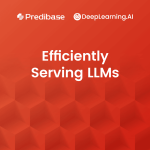Join our new short course, Efficiently Serving Large Language Models, to build a ground-up understanding of how to serve LLM applications from Travis Addair, CTO at Predibase. Whether you’re ready to launch your own application or just getting started building it, the topics you’ll explore in this course will deepen your foundational knowledge of how LLMs work, and help you … [Read more...] about Efficiently Serving LLMs
Algorithms
Algorithms, Part I
This course covers the essential information that every serious programmer needs to know about algorithms and data structures, with emphasis on applications and scientific performance analysis of Java implementations. Part I covers elementary data structures, sorting, and searching algorithms. Part II focuses on graph- and string-processing algorithms. All the features of … [Read more...] about Algorithms, Part I
The Power of Object-Oriented Programming
Object-oriented programming (or OOP) is a model that allows you to organize data by classes and objects using attributes. It’s also one of the most popular types of programming, making it an essential skill to help you better communicate with programmers in your organization. In this four-week course from the University of Michigan, you will expand your knowledge of OOP and … [Read more...] about The Power of Object-Oriented Programming
Big Ideas in Programming: Expressing Yourself with Python
Harness the power of Python and its programming concepts to express yourself and refine all the work you do with this online course from the University of Michigan. This course is designed for anyone interested in learning Python. Whether you want to discuss programming with other professionals, teaching others to code or use the language to do your own creative coding, this is … [Read more...] about Big Ideas in Programming: Expressing Yourself with Python
Planning a Generative AI Project
Planning a Generative AI Project is the second course in a three-part series of Generative AI Essentials for Business and Technical Decision Makers. If you have not done so already, it is recommended that you start with the first course in the series called Introduction to Generative AI: Art of the Possible. In this course, you will learn about the technical foundations and … [Read more...] about Planning a Generative AI Project





